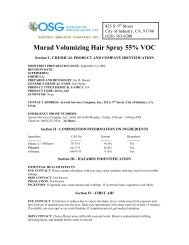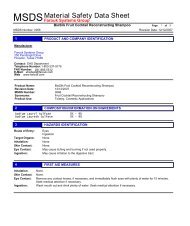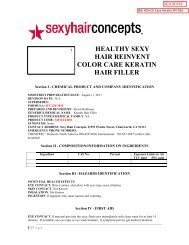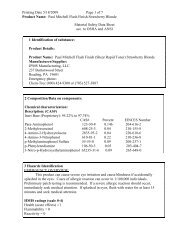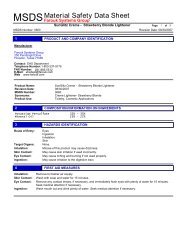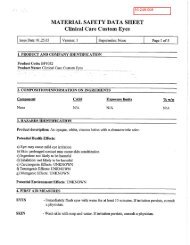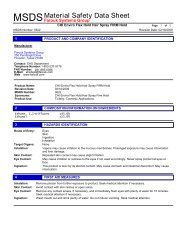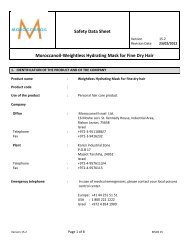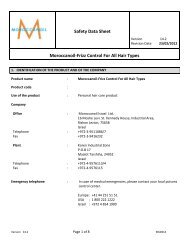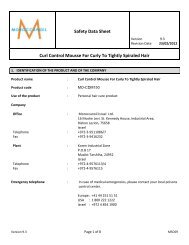01418001 Gena Nail Polish Thinner Butyl Acetate.pdf
01418001 Gena Nail Polish Thinner Butyl Acetate.pdf
01418001 Gena Nail Polish Thinner Butyl Acetate.pdf
You also want an ePaper? Increase the reach of your titles
YUMPU automatically turns print PDFs into web optimized ePapers that Google loves.
AMERICAN INTERNATIONAL INDUSTRIES<br />
Section 1. Product and Company Identification<br />
Product Name: <strong>Gena</strong> <strong>Nail</strong> <strong>Polish</strong> <strong>Thinner</strong> DATE: 5/3/2007<br />
Formula: 30-8033<br />
REV. NEW<br />
Item#:<br />
00904<br />
Manufacturer: American International Industries<br />
2220 Gaspar Ave<br />
Los Angeles, CA 90040<br />
Chem-Tel: (800) 255-3924<br />
Section 2. Composition / Information on Ingredients<br />
Hazardous Ingredients:<br />
Section 3. Hazardous Identification<br />
CAS # % Exposure Limits ppm<br />
Ethyl <strong>Acetate</strong><br />
141-78-6 50.0% ACGIH TLV/TWA: 400<br />
OSHA PEL/TWA: 400<br />
<strong>Butyl</strong> <strong>Acetate</strong> 123-86-4 40.0% ACGIH TLV/TWA: 150<br />
OSHA PEL/TWA: 150<br />
Mineral Spirits<br />
8032-32-4 10.0% None Established<br />
Potential Health Effects, Signs and Symptoms of Exposure:<br />
Primary Route of Entry: Eyes, skin or inhalation<br />
Eye:<br />
Liquid or vapors irritate the eyes; symptoms include stinging, excess blinking and tear<br />
production, excess redness and swelling. May cause temporary superficial injury of the cornea.<br />
Pre-existing eye disorders may be aggravated by exposure.<br />
Skin:<br />
Liquid irritates the skin. Prolonged contact can cause defatting and drying of the skin.No<br />
evidence of harmful effects from skin absorption is available. Pre-existing skin disorders may<br />
be aggravated by exposure.<br />
Ingestion:<br />
Inhalation:<br />
Swallowing a large quantity may cause nausea and CNS depression.<br />
Inhalation of vapors may cause irritation of the nose and throat. Inhalation of high vapor<br />
concentrations may cause cetral nervous system (CNS) depression. Symptoms of CNS<br />
depression include: giddiness, headache, drowsiness, dizziness and nausea. In extreme cases<br />
unconsciousness and death may occur.<br />
Chronic Exposure: Repeated skin contact may cause a dermatitis.<br />
MATERIAL SAFETY DATA SHEET<br />
Component<br />
Page 1 of 5
Section 4. First Aid Measures<br />
First Aid for Eye:<br />
First Aid for Skin:<br />
First Aid for Inhalation:<br />
First Aid for Ingestion:<br />
Note to Physician:<br />
AMERICAN INTERNATIONAL INDUSTRIES<br />
Flash Point (°F/°C): 30°F / -1.1(Lowest flashing component)<br />
Flammable Limit<br />
(vol%):<br />
Auto-ignition Temp.<br />
(vol%)<br />
General Hazard:<br />
Extinguishing Media<br />
Fire Fighting<br />
Instructions:<br />
Hazardous<br />
Combustion Products:<br />
Not available.<br />
Not available.<br />
Section 6. Accidental Release Measures<br />
MATERIAL SAFETY DATA SHEET<br />
Flush with large amounts of running water for 15 minutes while holding eyelids open. If easy to<br />
do, remove contact lenses. Get medical attention.<br />
Remove contaminated clothing or shoes. Flush skin with water. Follow by washing with soap<br />
and water. Seek medical advice if irritation develops.<br />
Remove to fresh air. Supply oxygen if breathing is difficult. If not breathing apply artificial<br />
respiration. Get medical attention.<br />
Get medical attention immediately.<br />
Section 5. Fire Fighting Measures<br />
This product contains ethyl acetate. Ingestion of large amounts of ethyl acetate requires gastric<br />
lavage with 4% sodium bicarbonate.<br />
DANGER! Extremely flammable. Clear area of unprotected personnel and isolate. Vapors are<br />
denser than air, flashback along vapor trail may occur. Vapor may explode if ignited in<br />
enclosed space. Product components will float and can be reignited on surface of water.<br />
Use extinguishing media such as foam, dry chemical, or carbond dioxide. Water in straight<br />
hose stream may scatter product and spread the fire. Cool containers exposed to heat with<br />
water spray to prevent vapor pressure buildup leading to container rupture.<br />
Approach fire from upwind side. Avoid breathing smoke, fumes, mist or vapors. Firefighters<br />
wear protective clothing and self contained breathing apparatus.<br />
Acrid smoke, irritating fumes, carbon monoxide, carbon dioxide and unidentified organic<br />
compounds.<br />
Page 2 of 5
Spill or Release<br />
Procedures:<br />
Section 7. Handling and Storage<br />
Handling & Storing:<br />
Engineering Controls:<br />
Personal Protection:<br />
Protective Clothing:<br />
AMERICAN INTERNATIONAL INDUSTRIES<br />
MATERIAL SAFETY DATA SHEET<br />
DANGER!: Extremely flammable. Keep unnecessary and unprotected people away. Isolate hazard<br />
area. Eliminate all ignition sources. Handling equipment should be grounded to prevent sparks. Stay<br />
upwind.<br />
Large Spill: Wear appropriate respirator and protective clothing. Shut off souce of leak if safe to do so<br />
Dike and contain. Water fog may be useful in suppressing vapor cloud. Keep spills and cleaning<br />
runoff out of municipal sewers and open waterways. Collect free product with vacuum truck or pump<br />
to storage container. Absorb residue with inert material then place wast in a chemical waste container<br />
for disposal. Flush area with water to remove trace residue.<br />
Small Spill: Absorb product with inert material then place waste in a chemical waste container for<br />
disposal. Seaol waste container for proper disposal.<br />
Keep liquid away from heat, sparks and flame. Static electricity may accumulate and create a<br />
fire hazard. Ground fixed equipment. Bond and ground transfer containers and equipment.<br />
Use with adequate ventilation. Prevent vapor accumulation. Keep containers closed when not<br />
in use. Containers even emptied will retain product residue and can contain explosive vapors.<br />
Do not cut, drill, grind, weld or perform similar operations on or near containers.<br />
Avoid breathing of mist or vapors. Avoid contact with eyes. Avoid prolonged or repeated<br />
contact with the skin. Do not swallow. Wash hands thoroughly after handling material and<br />
before eating, drinking, smoking or using restroom facilities.<br />
Section 8. Exposure Controls / Personal Protective Equipment<br />
Mechanical ventilation is recommended.<br />
If exposire may or does exceed occupational exposure limits, use a NIOSH approved respirator.<br />
Avoid contact with eyes; use chemical goggles to protect eyes if contact is likely. Wear<br />
chemical resistant gloves and other clothing as required to minimize contact. Launder<br />
contaminated clothing before reusing. Eye baths and safety showers should be available.<br />
Section 9. Physical and Chemical Properties<br />
Appearance @ 25°C: Clear colorless liquid<br />
with sweet ester odor<br />
Viscosity (RVT): Not applicable<br />
Odor @ 25°C: Characteristic Vapor Pressure: 33.5 mm Hg @ 20°C (est.)<br />
pH Not established Vapor Density: >3 (air = 1)<br />
Page 3 of 5
AMERICAN INTERNATIONAL INDUSTRIES<br />
MATERIAL SAFETY DATA SHEET<br />
Specific Gravity: 0.885 @ 25°C (est.) Evaporation Rate: >1 (n-<strong>Butyl</strong> <strong>Acetate</strong>=1)<br />
Ignition: Not available VOC: 7.38lb./gal (calc.)<br />
Melting Point: Not available<br />
Boiling Point: Not established<br />
Solubility in Water Slight<br />
Section 10. Stability and Reactivity<br />
Stability:<br />
Incompatibility (Materials to Avoid):<br />
Oxidizing agents, sodium hydroxide and other alkali metal hydroxides.<br />
Hazardous Polymerization:<br />
Will not occur.<br />
Conditions to Avoid:<br />
<strong>Butyl</strong> <strong>Acetate</strong><br />
Ethyl <strong>Acetate</strong><br />
<strong>Butyl</strong> <strong>Acetate</strong><br />
Ethyl <strong>Acetate</strong><br />
Stable<br />
Avoid heat, sparks and flame. Avoid vapor accumulation.<br />
Section 11. Toxicological Information<br />
LD50: 14130 mg/kg (oral-rat)<br />
LD50: 7100 mg/kg (oral-mouse)<br />
LC50: >1800 ppm/6 hr. (inhalation-rat)<br />
Skin irritation (guinea pig: Slight<br />
Eye irritation (rabbit): Moderate<br />
LD50: 11.3 ml/kg (oral-rat)<br />
Section 12. Ecological Information<br />
LC50: 100 mg/L/96 hr/Bluegill sunfish<br />
LC50: 44205 mg/L/96hr/Daphnid<br />
This product may be toxid to fish<br />
The product has a high biological oxygen demand and a potential to deplete oxygen in aqueous systems. It has a low<br />
potential to persist in the environment.<br />
Section 13. Disposable Considerations<br />
Page 4 of 5
AMERICAN INTERNATIONAL INDUSTRIES<br />
MATERIAL SAFETY DATA SHEET<br />
Classification and documentation is required before disposing of this product. If the product becomes waste material, it<br />
may be ignitable hazardous waste.<br />
Section 14. Transportation Information<br />
<br />
Proper Shipping Name (49CFR 172.101): Flammable Liquid n.o.s. (<strong>Butyl</strong> <strong>Acetate</strong>, Ethyl <strong>Acetate</strong>)<br />
Hazard Class: 3<br />
UN/NA: UN1993<br />
Packing Group: II<br />
Reportable Quantity (RQ)<br />
Section 15. Regulatory Information<br />
TSCA (Toxic Substance Control Act):<br />
The components of this product are listed on the TSCA Inventory<br />
CERCLA (Comprehensive Environmental Response Compensation and Liability Act):<br />
Reportable quantity from release or spill<br />
5000lb: butyl acetate or approximately 965 gallons product<br />
5000lb: ethyl acetate or approximately 2250 gallons product<br />
CWA (Clean Water Act, Section 311):<br />
Components of this product are considered oils. Spills into or leading into surface waters that<br />
cause a sheen must be reported to the National Response Center (800) 424-8802)<br />
SARA Title III (Superfund Amendments and Reauthorization Act):<br />
311/312 Hazard Catergoies: acute, ignitable<br />
313 Reportable Ingredients: None<br />
State Requirements:<br />
Section 16. Other Information<br />
Additional information available upon request.<br />
5000lb: butyl acetate or approximately 965 gallons product<br />
5000lb: ethyl acetate or approximately 2250 gallons product<br />
<strong>Butyl</strong> <strong>Acetate</strong> is regulated by MA, PA and NJ<br />
Ethyl <strong>Acetate</strong> is regulated by CA, MA, NY and PA<br />
Page 5 of 5



